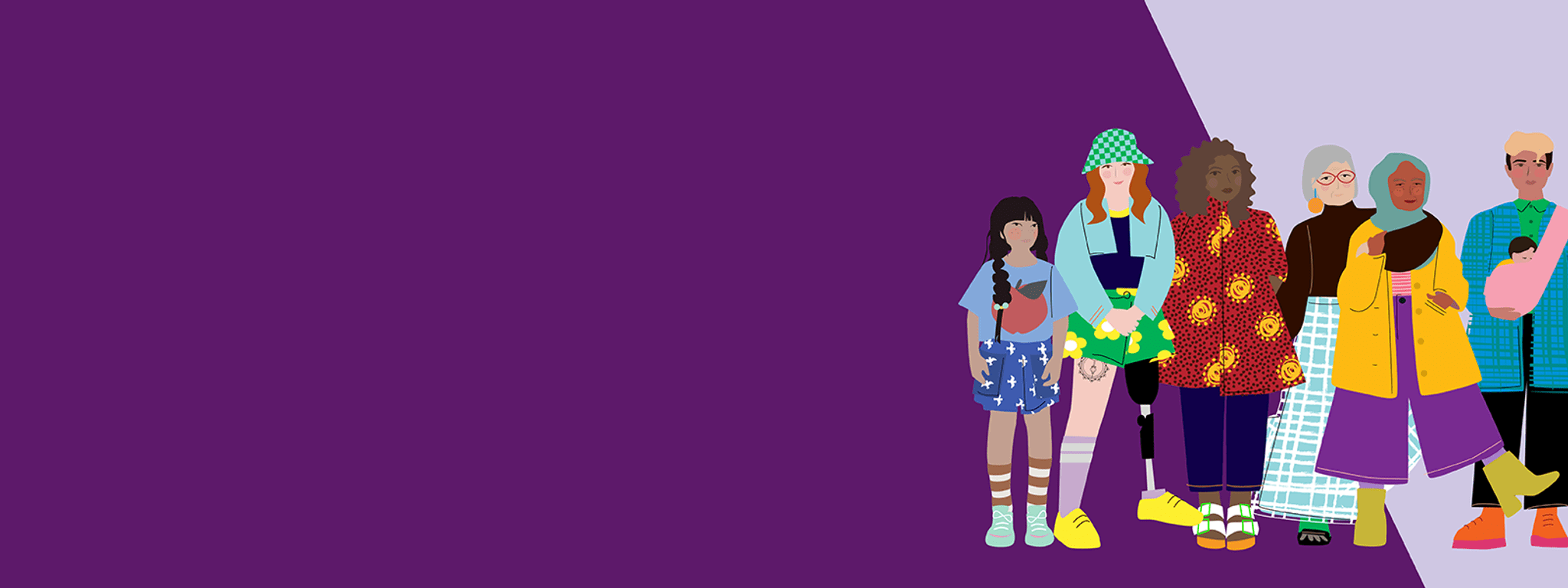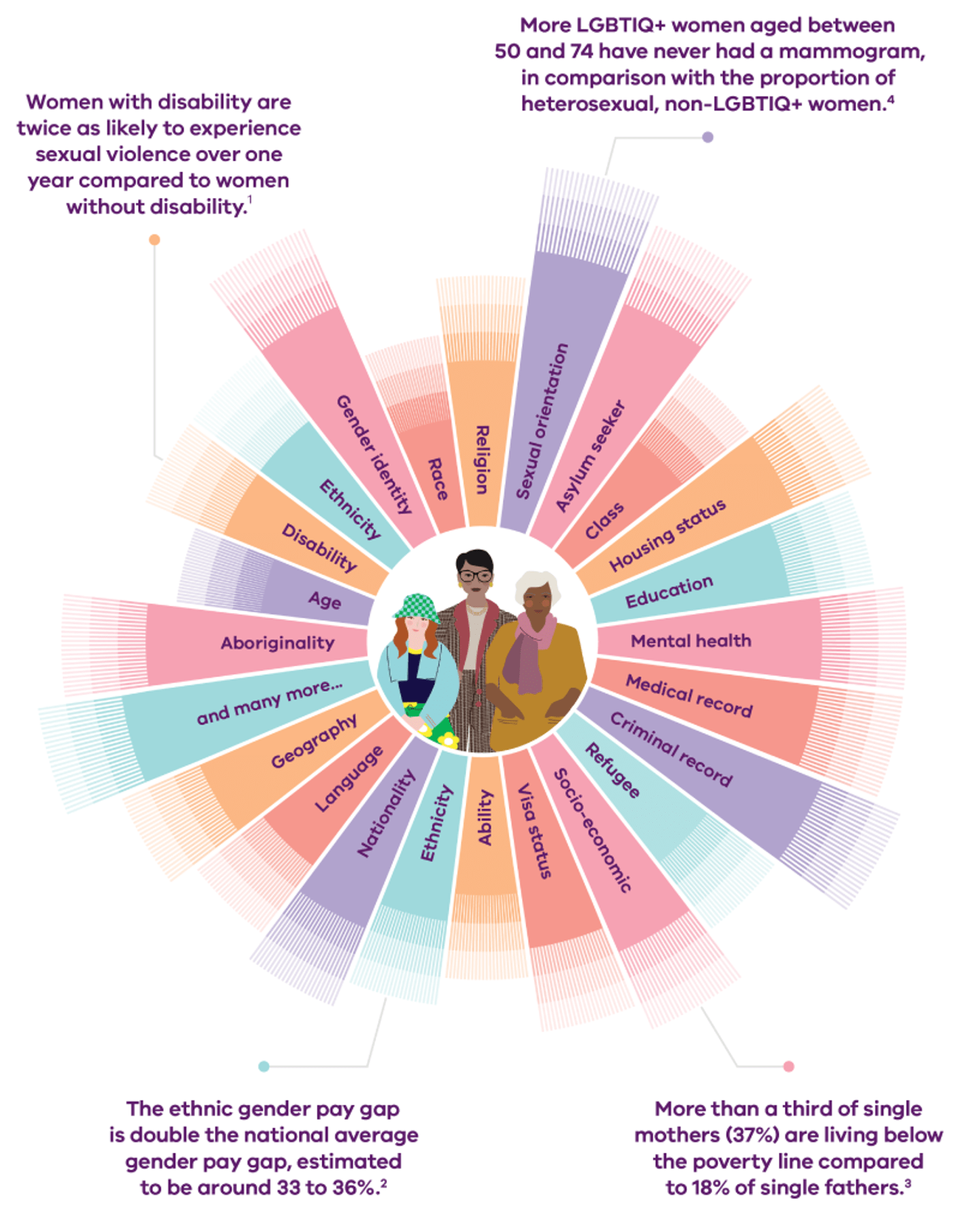Not everyone experiences gender inequality the same way. Gender inequality exists alongside other forms of disadvantage or discrimination based on identity. These include characteristics such as Aboriginality, age, disability, ethnicity, gender identity, race, religion, sexual characteristics, sexual orientation and other attributes.
Different parts of identity can expose people to many types of discrimination and marginalisation, and increase inequality and hardship.
Our equal state takes an intersectional approach to gender equality. In our work, we must:
- understand compounding inequalities
- define and collect better data and evidence
- listen to and learn from the lived experience of women, men, gender diverse people, families and communities.
We recognise that there is more work to do.
‘A truly gender equitable transformation of our society must be intersectional and see the whole person.’
– contributor via Engage Victoria
Explainer: what are gender norms and stereotypes?
Gender norms are society’s expectations and beliefs about how men, women and gender diverse people should behave. They shape attitudes and behaviours about gender. Gender norms are different from personal beliefs and actions.
Gender norms can create a continuous cycle of gender stereotyping. They can change over time as attitudes and beliefs evolve. They exist on an individual, relationship, community and societal level.
Rigid gender stereotypes and norms limit us all. They shape mentalities and how we see our role in society.
Australian men are more traditional in their gender attitudes than the global average, with 30% of Australian men agreeing gender inequality doesn’t really exist. [5]
28% of Australian men think women often make up or exaggerate claims of abuse or rape. [6]
In 2020-21, the Victorian Equal Opportunity and Human Rights Commission received 403 complaints related to workplace and everyday sexism, sexual harassment and gender discrimination. This includes:
- 38 on the basis of pregnancy
- 63 on parental status
- 176 on the basis of sex
- 102 on the basis of sexual harassment
- 24 on the basis of gender identity. [7]
The 2023 National Community Attitudes Survey [8] showed that:
- 41% mistakenly believe that domestic violence is equally perpetrated by men and women
- an alarming proportion of Australians mistrust women’s reports of violence, with 34% believing that it is common for women to use sexual assault accusations to get back at men
- 41% believe that many women mistake innocent remarks as sexist.
References
[1] Royal Commission into violence, abuse, neglect and exploitation of people with disability 2021, Alarming rates of family, domestic and sexual violence of women and girls with disability to be examined in hearing, Royal Commission website, 2021, accessed 06 February 2023. https://disability.royalcommission.gov.au/news-and-media/media-releases/alarming-rates-family-domestic-and-sexual-violence-women-and-girls-disability-be-examined-hearing
[2] R Whitson, ‘Culturally diverse women paid less, stuck in middle management longer and more likely to be harassed’, ABC, 12 March 2022, accessed 06 February 2023. https://www.abc.net.au/news/2022-03-12/why-cultural-diversity-matters-iwd/100899548
[3] Council of Single Mothers and their Children, ‘The feminisation of poverty: why we need to talk about single mothers’, CSMC, 2022, accessed 06 February 2023. https://www.csmc.org.au/2022/10/the-feminisation-of-poverty-why-we-need-to-talk-about-single-mothers/
[4] Victorian Agency for Health Information, The health and wellbeing of the lesbian, gay, bisexual, transgender, intersex and queer population in Victoria: Findings from the Victorian Population Health Survey, 2020, accessed 3 May 2023. https://vahi.vic.gov.au/sites/default/files/2021-12/The-health-and-wellbeing-of-the-LGBTIQ-population-in-Victoria.pdf
[5] The Global Institute for Women’s Leadership, International Women’s Day 2022, accessed 26 April 2023. https://www.ipsos.com/sites/default/files/ct/news/documents/2022-03/Int…
[6] The Global Institute for Women’s Leadership, International Women’s Day 2022.
[7] Victorian Equal Opportunity & Human Rights Commission, 2020–2021 Annual report, VEOHRC, 2021, accessed 23 December 2022. https://www.humanrights.vic.gov.au/static/17e7f07a6011ef9bf0002454f5a65…
[8] Australia’s National Research Organisation for Women’s Safety, Attitudes matter: Overall Australians attitudes towards violence against women have improved, but there is still a long way to go, ANROWS, 2023, accessed 26 April 2023. https://www.anrows.org.au/media-releases/attitudes-matter-ncas21-media-…
Updated


